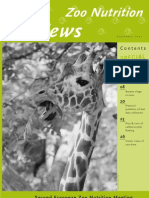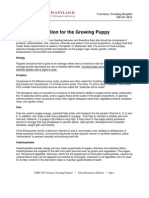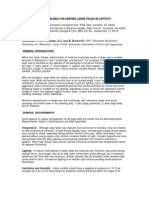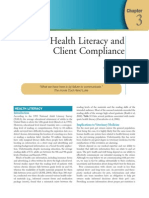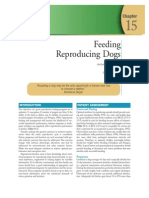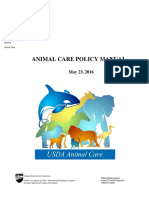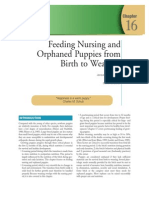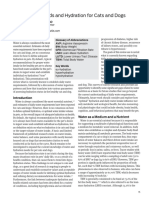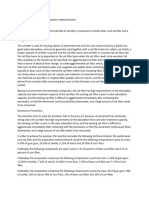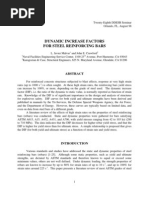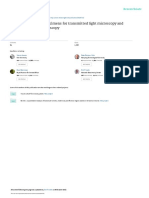Nutrition and Diet Evaluation
Nutrition and Diet Evaluation
Uploaded by
gabrielwerneckCopyright:
Available Formats
Nutrition and Diet Evaluation
Nutrition and Diet Evaluation
Uploaded by
gabrielwerneckCopyright
Available Formats
Share this document
Did you find this document useful?
Is this content inappropriate?
Copyright:
Available Formats
Nutrition and Diet Evaluation
Nutrition and Diet Evaluation
Uploaded by
gabrielwerneckCopyright:
Available Formats
ISSN 1479-5647
Zoo Research Guidelines
Nutrition and Diet Evaluation
Nutrition and Diet Evaluation
British and Irish Association of Zoos and Aquariums 2009
All rights reserved. No part of this publication my be reproduced or transmitted in any
form or by any means, electronic or mechanical, including photocopy, recording or
any information storage and retrieval system, without permission in writing from the
publisher.
Fidgett, A.L. and Plowman, A. (2009) Zoo Research Guidelines: Nutrition and diet
evaluation. BIAZA, London, UK.
First published 2009
Published and printed by:
BIAZA
Zoological Gardens,
Regents Park,
London NW1 4RY,
United Kingdom
ISSN 1479-5647
Nutrition and Diet Evaluation
Zoo Research Guidelines:
Nutrition and Diet Evaluation
Andrea L. Fidgett1 and Amy Plowman2
North of England Zoological Society, Chester Zoo, Chester, CH2 1LH; 2Paignton Zoo
Environmental Park, Totnes Road, Paignton, Devon, TQ4 7EU
With contributions from and acknowledgements for valuable comments: Andy Beer,
Ellen Dierenfeld, Anna Feistner and Stephanie Wehnelt; Sue Dow and Bristol Zoo for
hosting this workshop at the BIAZA Research Meeting at Bristol Zoo (2003).
Introduction to Nutrition and Diet Evaluation Guidelines
Effective management of species in zoos and aquariums requires
considerable knowledge of the biology of each species including
reproduction, behaviour, group dynamics, husbandry, nutrition, medical
needs and so forth. Scientific investigations are the basis for understanding
the animals in a zoo and assessing the way they are cared for. Through
careful observations and well-planned studies, much can be learned about,
for example, reproductive and social behaviour, growth and development,
and interactions with the physical environment.
These guidelines form part of a series designed to clarify the series of steps
that are usually involved in developing a research project in a zoo
environment. They discuss challenges which are characteristic for zoo
research projects which may differ from those encountered in laboratory or
field studies. Rather than repeat relevant advice offered elsewhere, the
authors suggest reading this document in conjunction with others from the
series, specifically: Project Planning and Behavioural Observations (Wehnelt et
al., 2003); Research by questionnaire (Plowman et al., 2006); Research using
Zoo Records (Fidgett et al., 2008).
Non-invasive techniques of diet evaluation can be successfully employed in
the absence of specific nutritional expertise or laboratory analytical facilities,
to provide information leading to the improvement of diets fed to zoo
animals. These guidelines focus on methods that can be undertaken without
specialist knowledge or equipment as we assume that this will be the
situation for most readers, and are thus aimed at those who may be relatively
new to this field. The chapter Feeding and Nutrition (Hosey et al., 2009) is
also useful background reading before any further investigation.
-3-
Nutrition and Diet Evaluation
The Nutrition and Diet Evaluation Guidelines are divided into the following
headings and it is useful to read all sections before beginning a project:
1. What do we mean by Nutrition and Diet Evaluation?
2. Dietary evaluation:
a. by weighing feeds and remains
b. by focal animal observations
c. by survey and review
3. Feed composition and nutrient calculation tools
4. Chemical analysis of foodstuffs and faeces
5. Dietary standards and recommendations
6. Final considerations
7. Further reading and other resources
Appendix I - Conducting an Intake Study
Appendix II Zoo Diet Questionnaire
1. What do we mean by Nutrition and Diet Evaluation?
Diet is the usual food of an animal, nutrition is the process by which a living
organism assimilates that food and uses it for growth and for replacement of
tissues. One of the challenges which zoological institutions face when
housing and maintaining exotic animals is providing them with a diet
adequate for achieving optimal nutrition.
There are a number of factors that need to be taken into account when
designing diets. These include: knowledge of the animal's diet composition
and foraging behaviour in the wild, knowledge of the functional anatomy of
its digestive tract, knowledge of dental morphology and adaptation to the
natural diet, knowledge of the bases on which animals select particular food
items, and an understanding of the implications that foraging and diet
selection have for social behaviour. This is a tall order, given our lack of
knowledge about many exotic species. It is compounded by the fact that
even when these factors are known, devising suitable substitutes for a wild
diet is hard. For example, we may know that 75% of a wild primate's diet is
fruit, yet feeding 75% fruit in captivity may provide a very different intake in
terms of nutrients, since fruits produced commercially for consumption by
humans (and thus readily available as components of zoo diets) are so
different from wild fruits (see OBrien et al., 1998).
The goal of zoo feeding programmes must be to provide nutritional support
for all stages of life, including egg development, gestation, lactation, and
early post-natal growth. Dietary deficiencies may result in increased
-4-
Nutrition and Diet Evaluation
susceptibility to disease, reduced fertility, reduced neonate viability, suboptimal yolk or milk production, retarded growth and physical deformities.
Deficiencies in diet presentation may result in obesity, stereotypies, or
increased aggression. It is clear that an understanding of the nutrition of
exotic animals is vital to their well-being and our ability to maintain them
successfully in captivity, yet animal nutrition is a new and relatively
unexplored field. Part of the problem is a lack of facilities in zoological
institutions and a lack of expertise. There is, thus, a strong need to develop
nutritional studies and departments in zoological institutions.
Research on nutrition is carried out both as a problem-solving exercise (in
relation to ill-health or apparent infertility) and as part of ongoing
programmes to improve animal husbandry. Studies carried out to solve
problems tend to focus on assessing the nutrient quality of the diet, whereas
the husbandry work is more oriented to food presentation methods and
behavioural and environmental enrichment involving food, and feeding and
foraging techniques. The aims are to enhance nutritional quality and
palatability and to stimulate natural foraging behaviour. The emphasis is on
non-invasive research methods. The ideal situation for diet evaluation would
be to monitor the intake of individual animals. However, for the evaluation to
be valid it is essential that the animals are behaving normally and separating
animals for the purpose of a study would likely cause stress, which in turn
may affect appetite and hence intake. Therefore, animals should not be
separated from their usual social groupings, normal routines disturbed as
little as possible, and most assessments can be done indirectly through
weighing food remains or analysing faeces.
2. Dietary evaluation
Currently in the UK, the Secretary of States Standards for Modern Zoo
Practice (2004) are designed to ensure that the welfare of animals in zoos is
protected, that zoos are safe places for the public to visit and, that zoos
participate in appropriate conservation and public education measures. The
Standards recommend best practice by which zoos are inspected and granted
licenses by local authorities. The Standards consider food and water as basic
needs and recommends the frequency of feeds and their nutritional balance
be taken into account. It states Food should be presented in a manner and
frequency commensurate with the natural behaviour of the species, as well as
its nutritional requirements, which may vary according to season. This
statement is expanded to a series of more specific recommendations,
including A record of all diets must be maintained.
-5-
Nutrition and Diet Evaluation
For many zoos, diets are recorded on kitchen whiteboards, a practical
solution to keep all keepers informed and easily allow for changes as species
or numbers of animals change. However useful, they only form a starting
point since they often lack sufficient detail about the feeds and quantities
used, data which are necessary for properly evaluating the efficacy of a diet.
a. Diet evaluation by weighing feeds and remains
The most commonly used means of diet evaluation involves weighing feeds
and remains. Also termed an intake study, it is relatively simple but can be
time-consuming. The purpose is to determine the actual amount of food fed
to and consumed by an animal or group of animals in an enclosure. Because
some diet components may be offered but not consumed, an evaluation of
the feeds actually consumed can provide considerably more information and
thus allow for a more accurate assessment of the diet than simple evaluation
of the diet offered. There is a step-by-step guide to conducting an intake
study in Appendix I.
Intake studies are run over a period of time, during which all the food items
offered to the study animals are weighed at the time of preparation. All food
remaining at the end of a feeding period is carefully collected and also
weighed. Some means of adjusting for changes in moisture content of the
uneaten food should be used, and this is achieved either by drying feed and
remains samples to a constant weight in a drying oven or through the use of
a dummy or control dish to assess changes in moisture content in the actual
climatic conditions experienced. Although the first method is more accurate,
it can often prove impractical for large volumes of food. Adjusted weights of
remains, subtracted from original weights fed, produce an estimate of feed
intake. These values are then averaged over the length of the diet trial. The
nutritional composition of the diet is typically estimated from data on the
nutrient composition of individual items in the diet and is therefore only as
accurate as the data upon which the estimate is based. Hence from weighing
feeds and collection of remains and the use of food tables/diet management
software it is possible to arrive at an estimate of nutrient composition.
Care must be taken to ensure the correct units are used, particularly when
the use of a conversion factor is required. Comparisons between the intakes
of different groups are best made on the basis of total group body weight,
rather than by the number of animals in each group.
-6-
Nutrition and Diet Evaluation
The data provide estimates of what is fed, and more importantly, what is
being consumed. Comparing these data sets may reveal whether nutritional
inadequacies apparent in the diet consumed are due to the animals' choice of
food items, or because the diet provided is inadequate. A simple index of
preference is also useful, whereby food items are categorized into low,
neutral or high palatability according to the percentage eaten.
b. Diet evaluation by focal animal observations
While attending to the animals' welfare, evaluating the diets of species in
their natural groupings is an unreliable means of estimating their individual
intakes. It relies on the assumption that every animal in a group eats an
identical amount and that no single animal eats all of one food item. Factors
such as age, sex, grouping, dominance status and breeding origin may affect
food choices made by individuals and direct behavioural observations made
at feeding times can provide valuable information about these choices.
To calculate individual feed intake through direct observation it is necessary
to know the average piece size of each food type and then to count how
many pieces of each food are consumed. This is relatively straightforward for
some species e.g. macaques that are fed discrete food items, such as pellets
and pieces of fruit or vegetables, which can be easily weighed (e.g. see
Plowman, 2008). However, for other animals that are provided with large or
non-discrete items, such as browse or exudates, or have access to paddock
grazing/browsing in their enclosure it is necessary to estimate bite size. For
browsers, average bite size can be determined by providing a known-weight
of browse, counting the number of bites taken then removing the browse and
re-weighing. This is likely to be affected by type of browse, relative leaf/twig
ratio (e.g. Shipley et al.,1999) and individual animal (especially size) so
average bite size needs to be determined over a range of these conditions
and preferably for each individual animal if feasible. For grazers, bite size
determination is also affected by sward type and structure (e.g. Burlinson et
al., 1991) and ideally should be estimated in a similar fashion for browsers
(above) using a sward sample in a movable container. If this is not feasible it
can be estimated by the hand-plucking method (e.g. Vries, 1995).
This type of study provides much more detailed information about individual
food preferences and consumption than can normally be obtained by an
intake study (a. above). However it is extremely time-consuming; observing
only one animal per feeding session will require a long period of time over
-7-
Nutrition and Diet Evaluation
which to establish a reliable data set if group size is large. Nevertheless it is
important to consider this type of diet evaluation in situations where there
may be strong social effects in group-living species, leading to
monopolization of palatable food items by one or a small number of
dominant individuals. Attempts to ensure equal access of all individuals to
all food types include feeding groups more food than is actually required
(these can lead to dominant individuals becoming overweight), and providing
food in more than one location. However, short of separating animals at
feeding times it is extremely difficult to guarantee that every animal will
obtain its 'fair' share.
Evaluation by this method also allows the determination of the contribution
of enclosure vegetation to the diet. Zoo enclosures are becoming increasingly
more naturalistic and contain more vegetation than in the past. Some of this
vegetation may have been chosen deliberately because it is palatable to the
animals and some deliberately because it is not palatable. If animals eat
significant amounts of enclosure vegetation this will have an impact on the
nutrient composition of their diet and also needs to be taken into account.
There is no way to do this other than by focal animal observation and even
then it is still difficult to reliably estimate weight of food eaten due to
variation in bite size (see above).
c. Diet evaluation by survey and review
This technique is increasingly used by EEPs/TAGs to gather diet data for a
single species across a range of zoos. If done well it can provide good
information on nutrient contents of diets which can be compared with
breeding and health records across institutions. Given the lack of data on
wild diets for many exotic species this is often the only way to determine
dietary recommendations (see section 5 below) However, this method has
major limitations in that the quality of data returned is usually not good
enough to do anything with at all. This is largely due to poor survey methods
which do not make clear what information is required; but also because to
provide the level of information needed requires quite a lot of effort on the
part of the respondent.
To be of any real use, diet survey respondents must give the weight of each
individual food item offered to the animal/group of animals each day over a
period of time. This period should be long enough to incorporate all the
regular variations in the daily diet typically a week in many zoos. Other
-8-
Nutrition and Diet Evaluation
information required includes the numbers, sexes and ages of animals in the
group and their weights if known. The manufacturer and product name of
any manufactured feeds must be included. To ensure that all this information
is received the surveyor must ensure that the questionnaire they send out is
very precise, clear, and easy to complete (see Zoo Research Guidelines:
Questionnaires for further advice on how to conduct research by
questionnaire). An example of a good diet survey questionnaire is included in
Appendix II.
Even if a large number of institutions respond to a survey with excellent
information it must be remembered that, unlike the above methods, this
technique only tells us the diet actually offered - not what is actually
consumed. As previously stated, these can differ quite substantially but it is
unrealistic to expect many zoos to provide accurate actual consumption data.
The best way to acquire these data from many zoos is to actually visit them
and collect it yourself.
3. Feed composition and nutrient calculation tools
Having recorded the ingredients in a diet, along with quantities fed and
consumed, these data must then be combined with information about the
nutrient composition of each ingredient to provide a nutritional summary of
the diet. Various food tables are available in print and online, from which the
relevant nutrient values can be extracted and copied into a spreadsheet to
perform the calculations. Alternatively, Zootrition software is a
comprehensive electronic database with the facility to compare nutritional
content of specific food items and calculate overall nutritional composition of
diets.
-9-
Nutrition and Diet Evaluation
Table 1 Common zoo feed categories and the best sources of
composition information
Fruit, Veg,
Nuts, Seeds
AZAs Nutrition Advisory
Group (NAG) website
Forage
Whole
prey
91
92
Manufacturers Guaranteed
Analysis
Prepared feeds
/ supplements
McCance & Widdowsons
Composition of Foods
Peer-reviewed literature
USDA Nutrient Database
ZOOTRITION
93
9
9
93
9
See NAG Technical Paper 6: Hay and pellet ratios: considerations in feeding ungulates. 2See
USDA Publication Nutrient composition of whole vertebrate prey (excluding fish) fed in
zoos. 3Contains data for meat, fish and shellfish products as used for human consumption
(e.g. fish fillets, rather than whole fish).
1
The Royal Society of Chemistry publishes McCance and Widdowsons The
Composition of Foods (2002), now in its 6th Summary Edition. This is a
revised and updated set of official UK food tables, covering more than 1100
different types of food. The nutrient coverage of this edition has been
extended to include selenium, manganese, iodine and fatty acids. The text
also covers proximates, vitamins, inorganics and lists scientific names for
foods.
The United States Department of Agriculture (USDA) are responsible for
compiling equivalent food tables in North America and their Nutrient
Database is available to search online. The web address is for the home page
of their Agriculture Research Service Nutrient Data Laboratory, which has
other useful information in addition to the Nutrient Database link.
(www.nal.usda.gov/fnic/foodcomp/)
ZOOTRITION features:
Over 3000 feedstuffs with published nutrient values, many unique to zoo
and wildlife species.
Comprehensive information covering nutrient recommendations for US
domestic and zoo species, the latter largely based on AZA Species Survival
Plan and Taxon Advisory Group nutrient specifications and
- 10 -
Nutrition and Diet Evaluation
recommendations for several species are from international husbandry
guidelines.
Energetics calculator to estimate energy needs based on animal
taxonomy, food habits, physiological stage, and activity levels.
Only data from peer-reviewed sources are considered for inclusion in the
locked global database embedded within Zootrition. However, most of
the information on feedstuffs and nutrient recommendations is still of
North American origin.
When using either published tables or software programmes as nutrient
calculation tools, be aware the final nutrient values are calculated, not
measured. In all instances, missing data (indicated by a dash -) do not
indicate the nutrient is not present. It simply means the specific content for
the feed was not assayed and there are no available data. Thus totals for a
diet or combination of feeds should be indicated as minimum calculated
values only.
4. Chemical analysis of foodstuffs and faeces
Chemical analysis of faeces and foodstuffs is a non-invasive technique
because it does not directly involve the animal. Most zoos do not have the
facilities to do these analyses so must rely on external collaborations.
Chemical analysis of foodstuffs is important for food types which do not
appear in existing databases or which might be very variable depending on
region, storage, growth conditions etc. Chemical analysis of faeces allows the
determination of the apparent digestibility of nutrients from the diet. It is
often important to analyse the digestibility for species for which it is difficult
to provide food in its natural form.
The chemical analysis of a food gives us values for the total amounts of
particular nutrients that are present. Commonly, when a food is to be
analyzed, it is first treated with a strong acid, or an enzyme, that breaks up
complex materials into simpler, soluble products. This mimics digestion,
which is essentially the breaking down of feed items or rather their
chemical constituents (carbohydrates, fats, proteins etc.) - in the body, into a
form that can be absorbed by the blood stream. Digestion involves physical,
chemical and enzymatic processes all along the gastrointestinal tract, so
digestibility can be considered a measure of how well this works. There may
be other chemicals in food items which are not nutrients (e.g. tannins); these
- 11 -
Nutrition and Diet Evaluation
may be toxic or reduce the consumption or digestion of those nutrients
which are present.
However, it is important to differentiate between chemical analysis of feed or
faeces, and how much a digestive system will be able to extract in a form
that can be absorbed into the bloodstream. The term digestibility may be
used to designate this, but depending on the nutrient in question, the term
bioavailability may be more appropriate and the final measure of
bioavailability must therefore be some overall response of the subject to a
test dose of the food in question. Specialist expertise may be required to
assist with the interpretation of the data generated.
5. Dietary standards and recommendations
Having collected data on what is being fed, how much is being fed, and then
calculating or measuring the nutritional content, the final consideration is
which standards to use for assessing the adequacy of a diet.
A preferable situation is when comparisons can be made between captive
diets and data collected from animals in the wild. The majority of field
studies of feeding ecology have tended to focus on the proportion of time
that animals spend feeding on different food types, rather than their actual
intake rates because the latter are often very difficult or impossible to obtain.
In addition, it is only rarely that food samples are collected and analysed for
actual nutrient content. Sterling [1993] was able to collect these data for ayeayes, mainly because of the low dietary diversity of the species in the wild.
In the absence of data from the wild, dietary standards can sometimes be
developed from captive situations where the animals are healthy and breed
well. Often well-studied nearest-relative domestic species are used as
nutritional models for exotic species. However this is not always a good
technique since taxonomic closeness does not always confer similar foraging
habits and nutritional requirements.
National Academies web page (www.nationalacademies.org)
The National Research Council Committee on Animal Nutrition produces a
series of reports on the Nutrient Requirements of Domestic Animals. This
includes publications on laboratory animals, poultry, swine, cats, horses,
non-human primates etc. To find out more about these publications look on
the National Academies web page (www.nationalacademies.org/). Use
- 12 -
Nutrition and Diet Evaluation
SEARCH, and look for Nutrient Requirements of Domestic Animals: Report
Series in The National Academies Only.
AZA Nutrition Advisory Group (www.nagonline.net)
AZA formed a scientific advisory group, the Nutrition Advisory Group (NAG),
giving the discipline, and/or practice of nutrition appropriate recognition.
The NAG facilitates improved communication and coordination among
nutritionists and those requiring nutrition information (i.e., AZA management
groups, AZA member institutions). The website is excellent, featuring
information and papers freely available to download for all. Nutrition
Chapters from published Husbandry Manuals: many Taxon Advisory Groups
(TAGs) or Species Survival Plans (SSPs) publish manuals of information on
their species of interest. The website lists those that have provided
information to the NAG about their husbandry manuals. Links allow the user
to view or download the chapter for use. NAG also produces an ongoing
series of technical papers and these are:
1 - Hay quality evaluation
2Vitamin D and ultraviolet radiation: meeting lighting needs for captive
animals
3Feeding captive insectivorous animals: nutritional aspects of insects as
food
4Elephants: nutrition and dietary husbandry
5Feeding captive piscivorous animals: nutritional aspects of fish as food.
6Hay and pellet ratios: considerations in feeding ungulates
7Leaf-eating primates: nutrition and dietary husbandry
8Assessment of nutritional status of captive and free-ranging animals
9Micronesian kingfishers: nutrition and dietary husbandry
10 - Quality control of feedstuffs: nutrient analyses
11 - Asian small-clawed otters: nutrition and dietary husbandry
12 - Penguins: nutrition and dietary husbandry
13 - Callitrichids: nutrition and dietary husbandry
EAZA Nutrition Group (www.eaza.net)
EAZA is the European Association of Zoos and Aquariums and also has a
Nutrition Group (ENG), with an online library of materials located on the main
EAZA website. Fewer husbandry guidelines have been written, nonetheless,
materials from numerous nutrition conferences are freely available for
download.
- 13 -
Nutrition and Diet Evaluation
6. Final considerations
These guidelines focus on diet evaluation in terms of nutrient quality.
However, devising a diet of optimum nutrient content is of little benefit if the
animals do not eat it and thus palatability is another important consideration.
But providing a good diet that is readily eaten by the animals is not sufficient
if distribution or social effects inhibit or limit adequate intake by certain
individuals. Although not covered in these guidelines, the presentation and
distribution of food needs to be considered in parallel with diet formulation,
to ensure that all individuals have equal, or near equal, access to food
resources, and that monopolization of feeding sites or preferred food items
does not occur. Finally, since finding and consuming food may occupy a
substantial proportion of daily activity in the wild, simply providing a good
diet, well distributed to ensure equal access to all, may still not be sufficient
if the animals consume their daily energy intake in an extremely short time
period. Thus behavioural and environmental enrichment is an extremely
important component of providing captive exotics with appropriate nutrition.
Many of the diets fed to exotic animals in captivity have been devised from
'lore' handed down, based on the belief that diets of the approximate foods
eaten in the wild will be adequate for the majority of zoo animals - "Monkeys
have been fed fruits and vegetables, carnivores slabs of meat, and
insectivores trays of mealworms without regard to nutritional composition"
[Oftedal & Allen, 1996, p.109]. However, dietary evaluation often presents a
very different picture, and assessing actual nutrient quality allows the
formulation of diets which are more nutritionally appropriate for the species
in question. Since an increasing number of exotic animals are also of
conservation concern, a greater understanding of wild animal nutrition will
enhance our ability to care for them appropriately in captivity. The field of
exotic animal nutrition is thus an important growth area for the future, and
one in which zoological institutions can play a leading role.
7. Further reading and other resources
Alexander, R.M. (1999). Energy for Animal Life. Oxford University Press,
Oxford.
Allen, M. E. and Oftedal, O. T. (1996). Essential nutrients in mammalian diets.
In: Wild Mammals in Captivity: Principles and Techniques, Kleiman, D.
G., Allen, M. E., Thompson, K. V., & Lumpkin, S. (Eds). University of
Chicago Press, Chicago, pp. 117-128.
- 14 -
Nutrition and Diet Evaluation
Allen, M. E., Oftedal, O. T., and Baer, D. J. (1996). The feeding and nutrition
of carnivores. In: Wild Mammals in Captivity: Principles and
Techniques, Kleiman, D. G., Allen, M. E., Thompson, K. V., & Lumpkin,
S. (Eds). University of Chicago Press, Chicago, pp. 139-147.
Burlinson, A.J., Hodgson, J. and Illius, A.W. (1991). Sward canopy structure
and the bite dimensions and bite weight of grazing sheep. Grass and
Forage Science 46: 29-38.
Dierenfeld, E.S. (1997). Captive wild animal nutrition: a historical perspective.
Proceedings of the Nutrition Society, 56(3): 989-999
Dryden, G.M. (2008). Animal Nutrition Science. CABI, Wallingford.
Fidgett, A.L., Clauss, M., Gansloer, U., Hatt, J.-M. and Nijboer, J. (2003). Zoo
Animal Nutrition, Volume II., Filander Verlag, Frth .
Fidgett, A.L., Clauss, M., Eulenberger, K., Hatt, J-M., Hume, I., Janssens, G. &
Nijboer, J. (2006). Zoo Animal Nutrition Volume III. Filander Verlag,
Frth.
Fidgett, A.L., Pullen, P.K. and Brunger, D. (2008). Zoo Research Guidelines:
Research Using Zoo Records. British Association of Zoos & Aquariums,
London.
Fisken, F. A. (2005). International Zoo Yearbook, Volume 39. Zoological
Society of London, London.
Food Standards Agency. (2002). McCance and Widdowson's The Composition
of Foods, 6th summary edition. Royal Society of Chemistry, Cambridge.
Hosey, G., Melfi, V. & Pankurst, S. (2009). Feeding and nutrition. In: Zoo
Animals Behaviour, Management, and Welfare. Hosey G., Melfi V. and
Pankurst S. Oxford University Press, Oxford, pp. 427-474.
Hume, I.D. (1999). Marsupial Nutrition. Cambridge University Press,
Cambridge.
Jarvis, C. (1966). International Zoo Yearbook, Volume 6. Zoological Society of
London, London.
Kelly, N. & Wills, J. (1996). Manual of Companion Animal Nutrition and
Feeding. BSAVA, Cheltenham.
Klasing, K.C. (1998). Comparative Avian Nutrition. CABI , Wallingford..
Kleiman, D. G., Allen, M. E., Thompson, K. V. & Lumpkin, S. (1996). Wild
Mammals in Captivity: Principles and Techniques. University of Chicago
Press, Chicago.
- 15 -
Nutrition and Diet Evaluation
McDonald, P., Edwards, R.A., Greenhalgh, J.F.D. & Morgan, C.A. (2002).
Animal Nutrition, 6th edition. Pearson Education, Essex.
McDowell, L.R. (2000). Vitamins in Animal and Human Nutrition, second
edition. Iowa State University Press, Ames.
McDowell, L.R. (2003). Minerals in Animal and Human Nutrition, 2nd edition.
Elsevier Science, Amsterdam.
Nijboer, J., Hatt, J-M., Kaumanns, W., Beijnen, A. & Gansloer, U. (2000). Zoo
Animal Nutrition Volume I. Filander Verlag, Frth.
O'Brien, T.G., Kinnaird, M.F., Dierenfeld, E.S., Conklin-Brittain, N.L.,
Wrangham, R.W. & Silver, S.C. (1998). What's so special about figs?
Nature, 392: 668.
Oftedal, O. T. & Allen, M. E. (1996a). Nutrition and dietary evaluation in zoos,
In Wild Mammals in Captivity: Principles and Techniques, Kleiman, D.
G., Allen, M. E., Thompson, K. V., & Lumpkin, S. (Eds). University of
Chicago Press, Chicago, pp. 109-116.
Oftedal, O. T. & Allen, M. E. (1996b). The feeding and nutrition of omnivores
with emphasis on primates, In Wild Mammals in Captivity: Principles
and Techniques, Kleiman, D. G., Allen, M. E., Thompson, K. V., &
Lumpkin, S. (Eds). University of Chicago Press, Chicago, pp. 148-157.
Oftedal, O. T., Baer, D. J., & Allen, M. E. (1996). The feeding and nutrition of
herbivores, In Wild Mammals in Captivity: Principles and Techniques,
Kleiman, D. G., Allen, M. E., Thompson, K. V., & Lumpkin, S. (Eds).
University of Chicago Press, Chicago, pp. 129-138.
Olney, P. J. S. (1976). International Zoo Yearbook, Volume 16. Zoological
Society of London, London.
Plowman, A.B., Hosey, G. & Stevenson, M. (2006). Zoo Research Guidelines:
surveys and questionnaires. BIAZA, London.
Pond, W.G., Church, D.C. & Pond, K.R. (1995). Basic Animal Nutrition and
Feeding, 4th edition. John Wiley and Sons, New York.
Robbins, C.T. (1993). Wildlife Feeding and Nutrition, 2nd edition. Academic
Press, San Diego, California.
Shipley, L., Illius, A.W., Kjell, D. Hobbs, N.T. & Spalinger, D.E. (1999).
Predicting bite size selection of mammalian herbivores: a test of a
general model of diet optimization. Oikos 84: 55-68.
Sterling, E.J., Dierenfeld, E.S., Ashbourne, C.J., & Feistner, A.T.C. (1994).
Dietary intake, food composition and nutrient intake in wild and
captive populations of Daubentonia madagascariensis. Folia
Primatologica, 62: 115-124
- 16 -
Nutrition and Diet Evaluation
Stevens, C.E. & Hume, I.D. (1995). Comparative Physiology of the Vertebrate
Digestive System, 2nd edition. Cambridge University Press, Cambridge.
Vries, M.F.W. (1995). Estimating forage intake and quality in grazing cattle: a
reconsideration of the hand-plucking method. Journal of Range
Management 48: 370-375.
www.nagonline.net (Nutrition Advisory Group)
www.cnsweb.org (Comparative Nutrition Society)
www.usda.gov (United States Department of Agriculture)
www.eaza.net (European Association of Zoos and Aquaria)
- 17 -
Nutrition and Diet Evaluation
Appendix I
Conducting an Intake Study
Ideally the study involves five (5) consecutive days of measuring individual
diet components both offered and remaining. To approximate a normal diet
schedule, collection during the five-day study period should ideally be
performed by the primary keepers for the animals.
All feed items must be weighed individually before feeding.
Items may be mixed after they have been weighed.
A desiccation dish must be set up separately from the main feed, to
measure the amount of water lost to the air. This dish should be placed
in an area as similar as possible to the exhibit being evaluated, but with
no animal access.
All items must be separated after animals have been fed. Each item must
again be weighed separately and recorded. If this is not possible due to
items being mixed into a porridge the total amount remaining should be
weighed and the amounts of each food type remaining estimated from the
relative amounts used to make the mixture.
Remaining food amounts need to be adjusted using desiccation factors
measured from the desiccation dish.
Recording Feed Intake
Prepare a list of feeds that are included in each animals diet and note the
number of animals in the exhibit.
Locate and become familiar with the scale that will be used.
Weigh each item of the diet separately.
Record individual feed weights for each dish, or the total amount of food
being scattered. Be sure to note any supplements. If an in-house mix of
ingredients is prepared, the components and recipe will be necessary for
full evaluation. Also note ingredient types, brands, and any other specific
information available.
Feed animal.
After normal amount of feeding time (i.e., animal is fed in AM and PM),
retrieve feed dishes and/or collect all food items remaining in the exhibit.
Separate all feed items from each other.
Weigh each item individually (including discarded items) and record on
intake sheet.
Continue this procedure for 5 consecutive days.
- 18 -
Nutrition and Diet Evaluation
Desiccation/Absorption Dish
The purpose is to estimate the amount of moisture lost to (or gained from)
the environment of the exhibit while the food sits out. Select a site for this
dish that is as similar to the exhibit being measured as possible. Try to
select an area that will minimize the amount of loss to rodents and insects.
Weigh all items into the dish and then leave it out for the same amount of
time as the main diet.
When feed dishes are collected, the desiccation dish can also be
evaluated.
Follow the same procedure as above for measurements; record data on a
daily desiccation record sheet.
Calculations
Sample calculations are for one item only. It will be necessary to repeat for
each ingredient, on each day of the trial. Numbers in BOLD are measured, all
others are calculated using the instructions below:
A
All wts in
grams
Offered
Remains
Start
End
APPLE
821
54
200
190
Correction
Corrected
Difference
Factor (as %)
Remains
Eaten
10
0.05
57
764
Desiccation Dish
Calculate desiccation correction factor (F) by first calculating the
difference in weight [C-D = E] in the desiccation dish, then expressing this
as a percentage of the initial weight [E/C = F]. In the example above, the
correction factor would be reported as 5%, but for calculations in the
spreadsheet is expressed as a fraction (0.05).
Apply correction factor to feed remains then add to feed remains to
calculate corrected remains [(BxF)+B = G].
Use corrected remains to calculate how much was eaten [A-G = H]. Since
original measurements were in whole numbers, it is appropriate to round
values accordingly.
Use columns A and H to describe diets in terms of food quantities offered
and eaten. Estimate nutrients offered and consumed using food tables or
diet management software.
- 19 -
Nutrition and Diet Evaluation
Suggested formats for data recording sheets
Data recording sheet for intake trial
Intake Trial No.:
Times of food
presentation:
Food Item
Day:
AM:
PM:
Date:
/collectio
AM:
n
Dish
3
4
Keeper:
PM:
Total Weight
Data recording sheet for correcting wet weight remains from desiccation dish
Food Item
All weights are in grams, unless stated otherwise
A - Fresh weight of food given at feeding time
B - Wet weight of food remains at time of collecting food
C - Weight difference (A - B)
% - Percentage (C / A)*100
- 20 -
Water Loss
C
%
Nutrition and Diet Evaluation
Appendix II
Zoo Diet Questionnaire
FEEDING PROGRAMME AT YOUR ZOO
1. Approximately how long has the diet described been in use?
2. Have animals been well maintained while on this diet? (e.g. have
the animals bred? Any recurring health problems that may be
diet-related? Any concerns for species in general even if not
observed in the collection here? Give brief details).
3. Instructions for food preparation (e.g. is fruit chopped
(finely/coarsely?) first thing or done the night before and stored in
fridge)
4. Are diets being eaten by pest birds, rodents and insects? (Give
indication of how much might be eaten by pests and whether a
significant problem?)
5. Are there opportunities for paddock feeding? (Do the animals
consume plants/insects in their enclosure which are not fed
directly?)
- 21 -
Nutrition and Diet Evaluation
6. Are amounts altered on a seasonal basis? (Brief description
changes for breeding diets; conditioning diets; diets for lactating
females; medical considerations etc.)
7. Notes and Remarks: (Include such data as how food is presented;
how well food is accepted; which are favourite items; is there a
pecking order for access to food? Any other comments that dont
apply elsewhere)
8. Reference Material (Details of most important references relevant
to wild or captive diets, including international husbandry manuals
if used)
- 22 -
Appendix II Zoo Diet Questionnaire
9.
If the diet is the same on daily basis indicate below stating DAILY; if some items are not fed daily please complete table for a full
week. Continue on separate sheets if necessary.
How many animals are fed from the diet described below? (males.females.juveniles).
Weight of feed item offered (grams)* and time of day (e.g. am/lunch/pm)
Feed Item**
Monday
Tuesday
Wednesday
Thursday
Friday
Saturday
Sunday
* Please provide weights (grams) wherever possible. If not possible please use typical measurement units e.g. 3 carrots, 4 mice, 2
bales
** For any manufactured feeds please provide exact manufacturer & product names + photocopies of the guaranteed analysis label if
possible.
Page 23 of 23
You might also like
- Aja Barber - Consumed - The Need For Collective Change - Colonialism, Climate Change, and Consumerism (2021, Grand Central Publishing) - Libgen - LiDocument228 pagesAja Barber - Consumed - The Need For Collective Change - Colonialism, Climate Change, and Consumerism (2021, Grand Central Publishing) - Libgen - LiroopalNo ratings yet
- Nutrition of Aging DogsDocument19 pagesNutrition of Aging DogsBrisbany AlcibarNo ratings yet
- Animal NutritionDocument714 pagesAnimal NutritionZozo Mostafa92% (12)
- LUCAS How Teeth Work 1st Ed 2004 PDFDocument372 pagesLUCAS How Teeth Work 1st Ed 2004 PDFRobert KruszynskiNo ratings yet
- Small Animal Clinical NutritionDocument16 pagesSmall Animal Clinical NutritionJairo Pereira100% (1)
- Nutrition Biochem MedDocument37 pagesNutrition Biochem MedM DNo ratings yet
- Feeding and Nutrition of AnteatersDocument6 pagesFeeding and Nutrition of AnteatersDidaNo ratings yet
- Animal Nutrition and DigestionDocument16 pagesAnimal Nutrition and DigestiongabrielwerneckNo ratings yet
- How To Anaesthetize A GiraffeDocument4 pagesHow To Anaesthetize A Giraffeltrathie3087100% (2)
- Diet, Feeding and Nutritional Care of Captive Tigers, Lions and LeopardsDocument5 pagesDiet, Feeding and Nutritional Care of Captive Tigers, Lions and LeopardsMark HietalaNo ratings yet
- Handbook of Wild and Zoo AnimalsDocument357 pagesHandbook of Wild and Zoo Animalsgabrielwerneck100% (1)
- Custom-Mapping Digifant-1 PDFDocument9 pagesCustom-Mapping Digifant-1 PDFNenad Chip Tuning AleksicNo ratings yet
- GST101 Summary With Past QuestionDocument43 pagesGST101 Summary With Past QuestionEkwochi Betilla100% (6)
- User Manual For CAN Logger Application and Breakout CablesDocument6 pagesUser Manual For CAN Logger Application and Breakout CablesfadholiNo ratings yet
- Nutritional Guidelines 2012Document75 pagesNutritional Guidelines 2012Raulimar Hernandez RamosNo ratings yet
- EAZA-Zoo Nutrition News 2Document36 pagesEAZA-Zoo Nutrition News 2ionut7791No ratings yet
- VMD 512 Zoo/wild Animal Breeding, Nutrition, Management and Health CareDocument20 pagesVMD 512 Zoo/wild Animal Breeding, Nutrition, Management and Health Caresudheer babu arumbaka100% (4)
- Taurine and Zoo Felids Considerations of Dietary and Biological Tissue Concentrations 2007 Zoo BiologyDocument15 pagesTaurine and Zoo Felids Considerations of Dietary and Biological Tissue Concentrations 2007 Zoo BiologygabrielwerneckNo ratings yet
- Small Animal Clinical NutritionDocument21 pagesSmall Animal Clinical NutritionMiguel Angel Herrera Andrade100% (1)
- Nutrition For The Growing Puppy: EnergyDocument5 pagesNutrition For The Growing Puppy: EnergyenigmaticmerkabaNo ratings yet
- Immunolocalization of Aquaporin-5 Expression in Sweat Gland Cells From Normal and Anhidrotic Horses (Pages 17-23)Document7 pagesImmunolocalization of Aquaporin-5 Expression in Sweat Gland Cells From Normal and Anhidrotic Horses (Pages 17-23)jenNo ratings yet
- Zoo Guidelines For Keeping Large Felids in CaptivityDocument5 pagesZoo Guidelines For Keeping Large Felids in CaptivitySadaqat AliNo ratings yet
- Small Animal NutritionDocument25 pagesSmall Animal NutritionJairo PereiraNo ratings yet
- Small Animal Clinical NutritionDocument12 pagesSmall Animal Clinical NutritionJairo Pereira100% (1)
- Jean Dodds Nutrition IssueDocument4 pagesJean Dodds Nutrition IssueMaca Donoso Alpencross Berneses100% (1)
- Nutrition Growing KittenDocument5 pagesNutrition Growing KittenAngelo MONo ratings yet
- Small Animal Clinical NutritionDocument14 pagesSmall Animal Clinical NutritionJairo Pereira100% (1)
- Small Animal Clinical NutritionDocument8 pagesSmall Animal Clinical NutritionMiguel Angel Herrera Andrade100% (1)
- 6 Certificate Course in Clinical Nutrition 01012019Document17 pages6 Certificate Course in Clinical Nutrition 01012019Ryzhon Dragon0% (1)
- Nutrition 1200 - Course OutlineDocument11 pagesNutrition 1200 - Course OutlineSarahNo ratings yet
- Animal Nutrition - A GuideDocument163 pagesAnimal Nutrition - A GuideJimmyNo ratings yet
- Body Condition Score For Dogs and CatsDocument4 pagesBody Condition Score For Dogs and CatsRizwanNo ratings yet
- Animal Care Policy ManualDocument42 pagesAnimal Care Policy ManualQueremosabarrabás A BarrabásNo ratings yet
- Small Animal Clinical NutritionDocument15 pagesSmall Animal Clinical NutritionJairo Pereira100% (1)
- Problem-Based Feline MedicineDocument1,485 pagesProblem-Based Feline MedicineYanhara SandovalNo ratings yet
- Small Animal Clinical NutritionDocument6 pagesSmall Animal Clinical NutritionJairo Pereira100% (1)
- Sodium Butyrate in Animal NutritionDocument23 pagesSodium Butyrate in Animal NutritionÖmer AhsanNo ratings yet
- Nutrition Workshop Proceedings 2011Document127 pagesNutrition Workshop Proceedings 2011lshl200000No ratings yet
- Animal Nutrition and FeedingDocument16 pagesAnimal Nutrition and Feedingmarianette balucasNo ratings yet
- Management of Acute Pancreatitis in DogsDocument13 pagesManagement of Acute Pancreatitis in Dogsluufer19No ratings yet
- Principles of Pet Food PalatabilityDocument5 pagesPrinciples of Pet Food PalatabilityDalaneze João VictorNo ratings yet
- He4 Module1Document8 pagesHe4 Module1Shane Daughty Serdoncillo GarciaNo ratings yet
- Dietary Assessment Methods in Nutrition EpidemiologyDocument14 pagesDietary Assessment Methods in Nutrition EpidemiologyArMadea De'aMra100% (1)
- Small Animal Clinical NutritionDocument9 pagesSmall Animal Clinical NutritionJairo Pereira100% (1)
- Animal Nutrition, 7th EditionDocument855 pagesAnimal Nutrition, 7th EditionFilon Ioan AlexandruNo ratings yet
- Water Needs and Hydration For Cats and Dogs - Brain M.zanghiDocument9 pagesWater Needs and Hydration For Cats and Dogs - Brain M.zanghiann nnNo ratings yet
- Relevance of Biochemistry To Veterinary MedicineDocument3 pagesRelevance of Biochemistry To Veterinary Medicineolawandeilo123No ratings yet
- Animal Nutrition ScienceDocument624 pagesAnimal Nutrition ScienceGhazali BalochNo ratings yet
- PDF Nutrition CM 1 CU 1 LEC WEEK 1Document27 pagesPDF Nutrition CM 1 CU 1 LEC WEEK 1Zharm MayNo ratings yet
- Swine EuthanasiaDocument20 pagesSwine Euthanasia18ovejasNo ratings yet
- Ring Tailed LemurDocument50 pagesRing Tailed LemurToha PutraNo ratings yet
- Amino Acids in Animal NutritionDocument526 pagesAmino Acids in Animal Nutritiondanielguerin100% (1)
- Feeding Dairy Cows ManualDocument264 pagesFeeding Dairy Cows ManualJose GutierrezNo ratings yet
- Pancreatitis Cronica Dog-CatDocument14 pagesPancreatitis Cronica Dog-CatSamantha Orozco PinedaNo ratings yet
- Zeolite Tofu Cat Litter and Preparation Method ThereofDocument17 pagesZeolite Tofu Cat Litter and Preparation Method ThereofFranz Marie Esther GuillemNo ratings yet
- Adolescence NutritionDocument43 pagesAdolescence NutritiontatadhNo ratings yet
- Preview PDFDocument117 pagesPreview PDFbernardo100% (1)
- Small Animal Clinical NutritionDocument12 pagesSmall Animal Clinical NutritionJairo Pereira100% (1)
- New Horizons in Pharmaceutical & Biomedical SciencesDocument360 pagesNew Horizons in Pharmaceutical & Biomedical SciencesPrema PérezNo ratings yet
- Homeopathic First Aid for Donkeys: Emergencies and Common AilmentsFrom EverandHomeopathic First Aid for Donkeys: Emergencies and Common AilmentsNo ratings yet
- 00 Evaluation of Fruit-Seed Based Diets For Parrots (Amazona SP)Document6 pages00 Evaluation of Fruit-Seed Based Diets For Parrots (Amazona SP)gabrielwerneckNo ratings yet
- An Evaluation of Browse Silage Production As A Feed Component For Zoo Herbivores - ZOO TORONTODocument1 pageAn Evaluation of Browse Silage Production As A Feed Component For Zoo Herbivores - ZOO TORONTOgabrielwerneckNo ratings yet
- Nutrition of The Tamandua I. Nutrient Composition of Termites and Stomach Contents From Wild TAMANDUA BANDEIRA PDFDocument16 pagesNutrition of The Tamandua I. Nutrient Composition of Termites and Stomach Contents From Wild TAMANDUA BANDEIRA PDFgabrielwerneckNo ratings yet
- Gross Intestinal Morphometry and Allometry in Ruminants - CLAUSSDocument13 pagesGross Intestinal Morphometry and Allometry in Ruminants - CLAUSSgabrielwerneckNo ratings yet
- Neo Tropical 12Document14 pagesNeo Tropical 12gabrielwerneckNo ratings yet
- Scarlet Macaw DietDocument8 pagesScarlet Macaw DietgabrielwerneckNo ratings yet
- Husbandry Manual For White Handed GibbonDocument92 pagesHusbandry Manual For White Handed GibbongabrielwerneckNo ratings yet
- Orangutan Husbandry ManualDocument434 pagesOrangutan Husbandry ManualgabrielwerneckNo ratings yet
- Bigcatdiet Dierenfield1994Document6 pagesBigcatdiet Dierenfield1994gabrielwerneckNo ratings yet
- Chimpanzee Care Manual PDFDocument109 pagesChimpanzee Care Manual PDFgabrielwerneck100% (1)
- The Ecology and Behavior of Chickadees and Titmice - An Integrated ApproachDocument344 pagesThe Ecology and Behavior of Chickadees and Titmice - An Integrated ApproachgabrielwerneckNo ratings yet
- Behavior, Nutrition, and Veterinary Care of Patagonian Cavies (Dolichotis Patagonum)Document12 pagesBehavior, Nutrition, and Veterinary Care of Patagonian Cavies (Dolichotis Patagonum)gabrielwerneckNo ratings yet
- Effects of Dietary Protein Intake On Renal FunctionDocument6 pagesEffects of Dietary Protein Intake On Renal FunctiongabrielwerneckNo ratings yet
- Full Download HMS Terror The Design Fitting and Voyages of a Polar Discovery Ship 1st Edition Matthew Betts PDF DOCXDocument55 pagesFull Download HMS Terror The Design Fitting and Voyages of a Polar Discovery Ship 1st Edition Matthew Betts PDF DOCXgerliomniia100% (1)
- P11 Dual Nature Radiation - MatterDocument1 pageP11 Dual Nature Radiation - Matterpujansonani677No ratings yet
- Dynamic Increase Factor For SteelDocument17 pagesDynamic Increase Factor For SteelEvelyn InocencioNo ratings yet
- Log Eventos Celda 8-4Document14 pagesLog Eventos Celda 8-4Luis AravenaNo ratings yet
- Welch Allyn Connex Vital Signs Monitor 6000 Series™: Service ManualDocument203 pagesWelch Allyn Connex Vital Signs Monitor 6000 Series™: Service ManualpatrickNo ratings yet
- The Inflection Circle Euler-Savaray Equation 5Document1 pageThe Inflection Circle Euler-Savaray Equation 5jeevan scplNo ratings yet
- Real Time and Embedded System AssignmentDocument10 pagesReal Time and Embedded System Assignmentmengstuhagos1223No ratings yet
- BelgJBotJansenetal1998 PDFDocument10 pagesBelgJBotJansenetal1998 PDFalexNo ratings yet
- Science7 - Combined Co Files - Mod1 To 6, 7.1, 7.2Document245 pagesScience7 - Combined Co Files - Mod1 To 6, 7.1, 7.2jeanwell.tandogNo ratings yet
- Ainstein DronedataDocument20 pagesAinstein DronedataNda SmuNo ratings yet
- Chemistry ProjectDocument19 pagesChemistry ProjectSANJANA MANOJ S/4851No ratings yet
- Laurelhurst Neighborhood Association Newsletter - September 2011Document9 pagesLaurelhurst Neighborhood Association Newsletter - September 2011EricFruitsNo ratings yet
- Electrical PlanDocument1 pageElectrical PlanAnthony Alvarez100% (1)
- HDL-MRCU.433 Home Control UnitDocument2 pagesHDL-MRCU.433 Home Control Unitabdessamad taoualNo ratings yet
- Soal Hitungan DosisDocument2 pagesSoal Hitungan DosissabrinaNo ratings yet
- TeSys D - LC1D09BD PDFDocument8 pagesTeSys D - LC1D09BD PDFbatuhanizmirli2No ratings yet
- 1 Appendix Functional Tests For SW-FAT Westrace MK2 - DocxDocument16 pages1 Appendix Functional Tests For SW-FAT Westrace MK2 - DocxRickyNo ratings yet
- Real Property Taxes Case DigestsDocument65 pagesReal Property Taxes Case DigestsJordan Tumayan50% (2)
- Python For Business Decision Making Asm2Document21 pagesPython For Business Decision Making Asm2Đặng Hoàng Nhật HưngNo ratings yet
- Jetson Agx Orindatasheet Update Module Series 2379600 v2Document2 pagesJetson Agx Orindatasheet Update Module Series 2379600 v2Manoel CoelhoNo ratings yet
- Full & Half Canvas SuitDocument3 pagesFull & Half Canvas SuitrabiulfNo ratings yet
- Unico Shield (V-1.1)Document7 pagesUnico Shield (V-1.1)Amlanjyoti BiswalNo ratings yet
- Ka SelectedDocument25 pagesKa SelectedMd. Farhan Islam100% (1)
- The Unlimited Use of CarsDocument2 pagesThe Unlimited Use of CarsFaisal AbdaNo ratings yet
- Tieng Anh 4Document5 pagesTieng Anh 4Trần Thị Kiều TrangNo ratings yet
- PhytoremediationDocument26 pagesPhytoremediationlkokodkodNo ratings yet
















